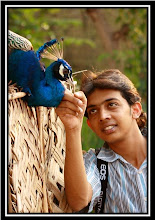Scientific Name: Coelognathus helena monticollaris
 |
| Trinket Snake |
Size:- Adult: 70 cm
- When Born: 25 cm
- Maximum: 1.5 m
Non Venomous Snake
Appearance: The light brown body with regular black cross bars. It can be identified by the broad dark stripe running along each side of the hind body to the tail tip, two short and dark parallel stripes on the neck, and an oblique stripe running from each eye to the outer edge of the mouth. Sometimes there may be another vertical stripe below the eye.
Nature: It is very famous for its threat display but the snake can be handled with care. They do strike repeatedly when threatened. Active by day and night.
Distribution: Endemic to Western Ghats and some regions around (Karnataka, Tamil Nadu, Kerala, Maharashtra and Goa). In Maharashtra found in ever green forests.
- When Born: 25 cm
- Maximum: 1.5 m
Non Venomous Snake
Appearance: The light brown body with regular black cross bars. It can be identified by the broad dark stripe running along each side of the hind body to the tail tip, two short and dark parallel stripes on the neck, and an oblique stripe running from each eye to the outer edge of the mouth. Sometimes there may be another vertical stripe below the eye.
Nature: It is very famous for its threat display but the snake can be handled with care. They do strike repeatedly when threatened. Active by day and night.
Distribution: Endemic to Western Ghats and some regions around (Karnataka, Tamil Nadu, Kerala, Maharashtra and Goa). In Maharashtra found in ever green forests.
Habitat: During summers, these snakes inhabit the termite mounds and crevices of rocky places while in winter, they prefer the low lying bushes and trees
Feeds on: Just like the famous rat snake of America, the trinket is prodigious rodent eating machine. It feeds on rats, lizards and small birds
Reproduction: The female snake lies around 6 - 8 long slender eggs. The young ones resemble the parents. Once a trinket had laid 8 eggs on February 14 and the young ones hatched out of it on April 11. Another snake had laid eggs in the month of December. They have also been spotted laying eggs during August.
It was a rainy day on the day 20th day of July 2010 when I rescued a trinket snake .As it was raining I did not release her later when examined I realized it was pregnant and I basically wanted keep her with me .
Couple of days I fed her with mouse. The day cam e on 2nd of July 2010 she started laying eggs, It was night 11.00 pm when she laid her first egg I was fortunate enough to record her laying egg. It was around 2am in the morning when she laid her 8th egg and that was the last egg.
 |
| Trinket Snake is a non-venomous constrictor species of colubrid snake |
After 2 days I released her back in the wild, I decide to incubate these eggs .after 70 days of constant incubation at 27degree Celsius and maintaining 75%humidity, I was successful to hatch all the eggs. Few days later when they all shed their skin I released them back in wild
 |
| Laying eggs |
 |
| clutch of eggs |
 |
| Hatching |
.
















